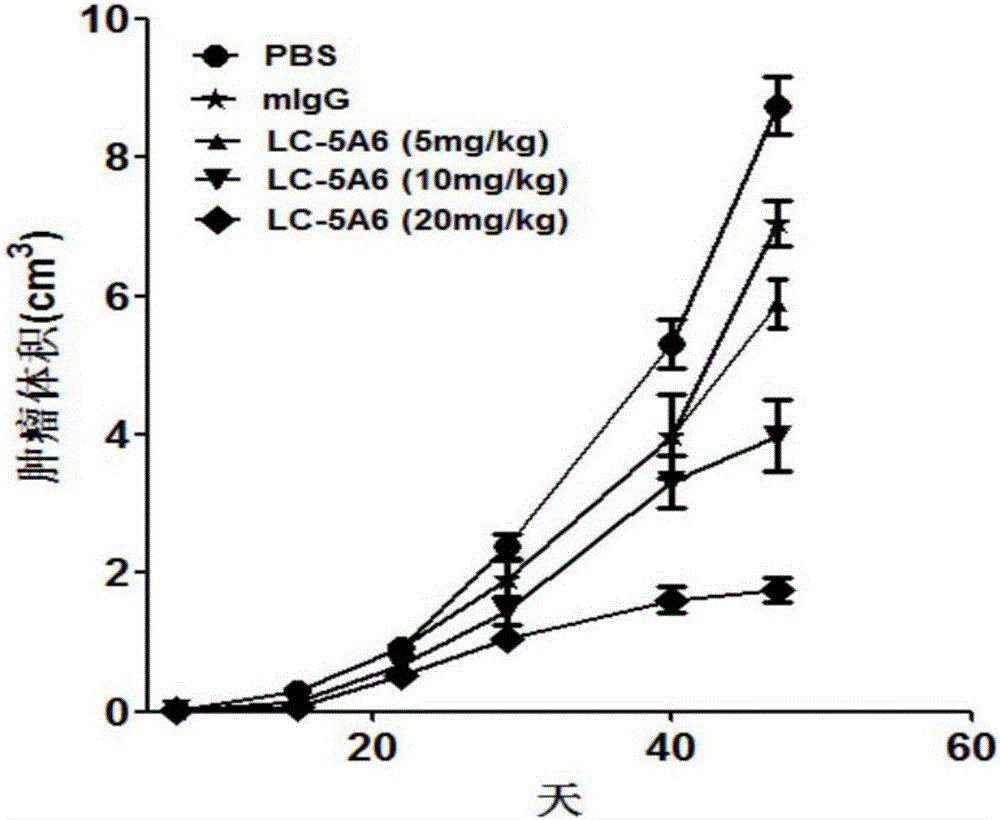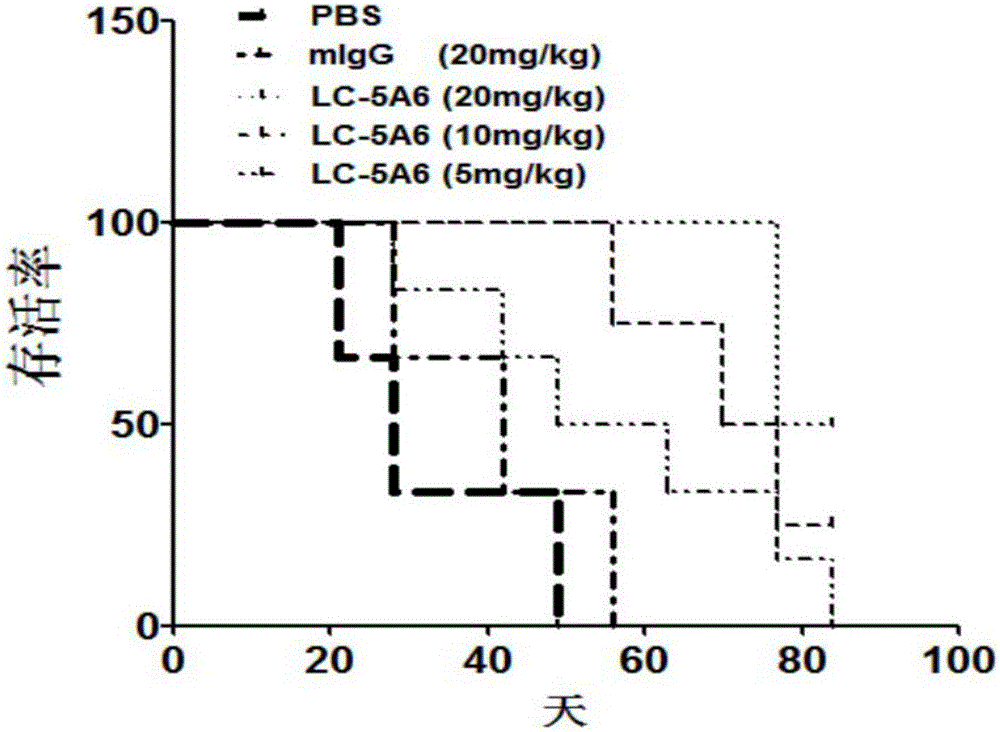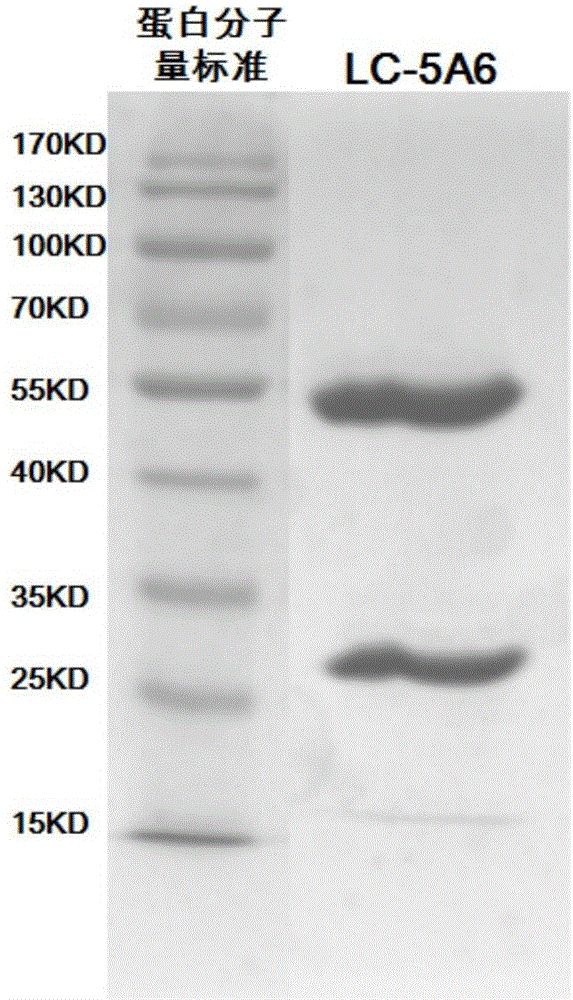Anti-human-lung-cancer-stem-cell monoclonal antibody
A monoclonal antibody and hybridoma cell line technology, applied in the direction of antibodies, anti-animal/human immunoglobulins, anti-tumor drugs, etc., can solve the problems of targeting tumor stem cells that have not been reported, and achieve the purpose of inhibiting the growth of lung cancer and inhibiting Effects on self-renewal, growth inhibition and recurrence
- Summary
- Abstract
- Description
- Claims
- Application Information
AI Technical Summary
Problems solved by technology
Method used
Image
Examples
Embodiment 1
[0029] Example 1 Preparation of Mouse Monoclonal Antibody Binding to Human Lung Cancer Stem Cell Membrane Surface Antigen
[0030] A new method of primary culture combined with transient subculture was used to isolate continuous passage cell lines that can produce lung cancer stem cells from human lung cancer tissues, and to establish an in vitro serum-free suspension culture technology that can effectively enrich lung cancer stem cells. The obtained lung cancer stem cells were fixed with paraformaldehyde, and Balb / c mice were immunized until the anti-human lung cancer stem cell titer of immunized mouse serum reached 1:50,000, and the mouse spleen cells were fused with mouse myeloma cells SP2 / 0 form hybridomas. The hybridoma clones were prepared by the methylcellulose plate method, and after the clones grew, they were picked and cultured in 96-well plates. The culture supernatant of each hybridoma clone containing the monoclonal antibody secreted by this clone was collected f...
Embodiment 2
[0031] Example 2 Screening of mouse monoclonal antibodies that specifically recognize membrane surface antigens of human lung cancer stem cells
[0032] The A549 spherical cells cultured in serum-free suspension were gently blown into single cells, inoculated at 2000 / well in a 96-well plate, cultured in serum-free medium for 24 hours, washed with PBS containing 1% BSA, and placed in each well Add 100ul of the culture supernatant of a hybridoma clone and incubate at room temperature for 2 hours; after washing five times with 1% BSA in PBS, add biotin-labeled secondary antibody and react at room temperature for 30 minutes; wash again with 1% BSA in PBS for five times and label with Cy3 Avidin was reacted at room temperature for 30 minutes; after washing five times with 1% BSA in PBS, the reaction of the hybridoma monoclonal antibody supernatant in the monoclonal antibody library with lung cancer stem cells was judged by fluorescence microscopy, and mouse monoclonal antibodies cap...
Embodiment 3
[0033] Example 3 Identification of tumorigenicity of cells recognized by monoclonal antibody secreted by hybridoma cell LC-5A6
[0034] A549 cells were prepared into single cells by trypsin digestion, added LC-5A6 antibody (5.0 μg / ml), incubated at 37°C for 1 hour, washed twice with PBS, added Percp-goat anti-mouse IgG, and incubated at 37°C in the dark for 30 minutes , sorted LC-5A6 by flow cytometry + cells, LC-5A6 - Cells were inoculated subcutaneously on the right side of the back of each nude mouse, 6 mice in each group. Surface marker negative group and unsorted group were used as controls. The long and short diameters of subcutaneous transplanted tumors were measured twice a week, and the tumor volume was calculated using the formula V=(π / 6)×(long diameter×short diameter×short diameter). As shown in the results, inoculation of LC-5A6 + Cell 1×10 3 One can form a tumor at 1 month, and the rate of tumor formation at 2 months is 6 / 6, while LC-5A6 - Cell 1×10 5 All f...
PUM
 Login to View More
Login to View More Abstract
Description
Claims
Application Information
 Login to View More
Login to View More - R&D
- Intellectual Property
- Life Sciences
- Materials
- Tech Scout
- Unparalleled Data Quality
- Higher Quality Content
- 60% Fewer Hallucinations
Browse by: Latest US Patents, China's latest patents, Technical Efficacy Thesaurus, Application Domain, Technology Topic, Popular Technical Reports.
© 2025 PatSnap. All rights reserved.Legal|Privacy policy|Modern Slavery Act Transparency Statement|Sitemap|About US| Contact US: help@patsnap.com



